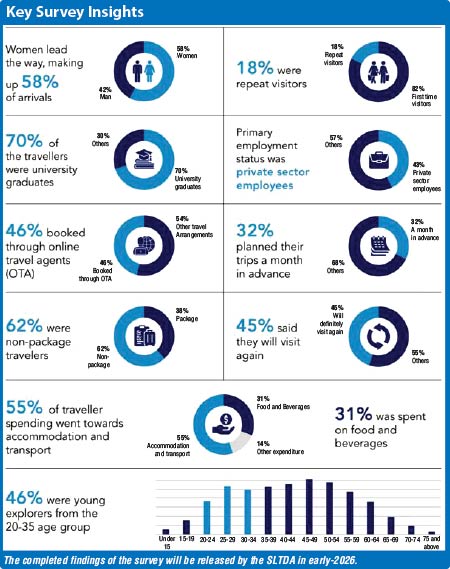Friday Nov 28, 2025
Friday Nov 28, 2025
Friday, 28 November 2025 05:36 - - {{hitsCtrl.values.hits}}
 Sri Lanka’s largest-ever tourism survey, “From Data to Decisions: Strengthening Tourism Through Evidence and Collaboration,” was unveiled yesterday, offering policymakers and industry stakeholders a roadmap to shape marketing, product development, and future development.
Sri Lanka’s largest-ever tourism survey, “From Data to Decisions: Strengthening Tourism Through Evidence and Collaboration,” was unveiled yesterday, offering policymakers and industry stakeholders a roadmap to shape marketing, product development, and future development.
The initiative, conducted by the Sri Lanka Tourism Development Authority (SLTDA) with support from the Market Development Facility (MDF) of Australia, saw a 12-month national airport exit survey from July 2024 to June 2025 uncover detailed insights into the motivations, demographics, and spending patterns of travellers entering and leaving the country.
The study, conducted through stratified random sampling, captured responses from 11,731 inbound tourists across all major source markets and 5,000 outbound Sri Lankan travellers, giving every passenger an equal opportunity to participate.
During the launch, both SLTDA and MDF representatives noted that the methodology strengthens the reliability and credibility of the findings, making it one of the most robust tourism data sets produced in recent years.
Most inbound tourists fall between 20 and 35 years, made up 46% of travellers surveyed, with 46% booking through online travel agents and 62% opting to travel independently. This cohort is defined by disposable income, a desire for immersive experiences, and ease of travel enabled by digital booking platforms. They travel light, spend strategically and “collect stories, not souvenirs,” reflecting a sharp global shift in tourism behaviour.
It revealed that women travellers accounted for 58% of all surveyed arrivals, and over 18% of tourists were repeat visitors. It was revealed that 45% of those surveyed said they planned to return.
Beaches topped the list of favourite experiences, while Galle, Ella, and Sigiriya emerged as the most visited destinations.
Officials of both the SLTDA and MDF opined that these patterns reinforce the importance of tailoring experiences by life stage: young adults seek pleasure and adventure, mid-career professionals combine business with leisure, and travellers over 60 are driven largely by spirituality.
Gender trends also reveal differentiated behaviour. Women are more inclined toward culture, culinary experiences and nature-based activities, while men dominate adventure and high-energy travel segments.
Sri Lanka continues to attract a visitor base with high education levels, including graduates, researchers, and professionals. This group values culture, heritage, nature, and responsible tourism, relying heavily on online research before making travel decisions.
It was noted that this underscores the need for a sharper, richer, and more consistent digital presence to match how these audiences consume information.
The survey notes a clear divide between tourists who book within 30 days and those planning six months or more ahead. Both groups remain vital to sustaining demand and stabilising seasonality.
Regional variations also matter. Western European and Chinese travellers typically arrive in groups or families, prioritising safety, authenticity, and curated experiences. Indian tourists span all segments such as solo, family and group, thanks to proximity, affordability, and strong cultural ties.
Young visitors prioritise adventure and nightlife, European travellers are drawn to wildlife and nature, Indians focus strongly on culture and spirituality, Germans actively seek hiking and trekking, and Russians and Americans favour Sri Lanka’s classic beach destinations.
The findings reinforce Sri Lanka’s positioning as a multi-niche destination requiring differentiated marketing strategies rather than a single narrative.
It also highlighted that the online booking platforms account for 46% of reservations, while travel agents handle 36% and direct bookings make up 16%. Younger tourists overwhelmingly book online, while older travellers still remain loyal to agents who offer reassurance and curated itineraries. The industry, analysts say, must now operate across “many worlds” of consumer behaviour.
Independent travellers spend $ 148.26 per day, dispersing their spending across local food outlets, transport providers and grassroots experiences. Russians lead spending among non-packaged visitors, particularly when travelling independently.
However, package travellers generate even greater value, spending $ 214.90 per day. The UK market dominates this segment, reflecting long-standing preferences for structured, predictable holidays. Older travellers, particularly those above 60, consistently opt for packages that offer convenience and safety.
Outbound travel is largely driven by men aged 45 to 54, travelling for pilgrimage and leisure. The survey suggests opportunities to develop curated itineraries blending spirituality with wellness-driven relaxation, tapping into a demographic with high travel readiness.
As with all sample surveys, it notes potential constraints, including time limitations, language barriers, self-reported spending inaccuracies and non-response bias. However, it was noted that the robustness of the methodology ensures the findings remain highly credible and relevant for policy and industry decisions.
The data paints Sri Lanka as a destination defined by stories, contrasts and multi-layered motivations. From first-time adventurers to repeat leisure travellers, from families to solo pilgrims, the country attracts diverse segments whose expectations continue to evolve.
Both SLTDA and MDF officials who shared insights asserted that Sri Lanka must design smarter experiences, diversify its attractions, refine its digital strategy, and build a more resilient and sustainable tourism model if it is to unlock the full economic value of a changing global traveller.
Since 2015, the MDF has been working with the SLTDA to strengthen its data systems and these findings will contribute to establishing a Tourism Satellite Account (TSA). This will be used as a critical tool to measure tourism’s economic impact, laying the foundation for evidence-based sector transformation.
A comprehensive report with deeper insights and policy recommendations will be released by the SLTDA early next year.